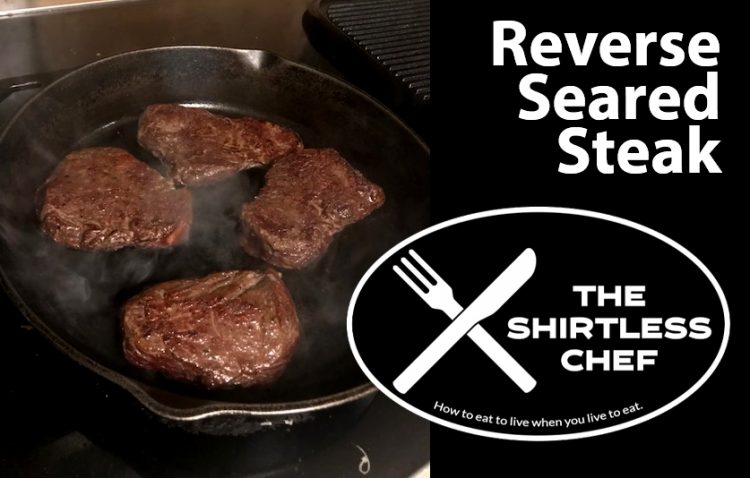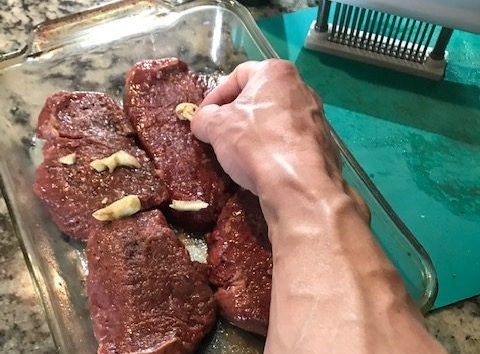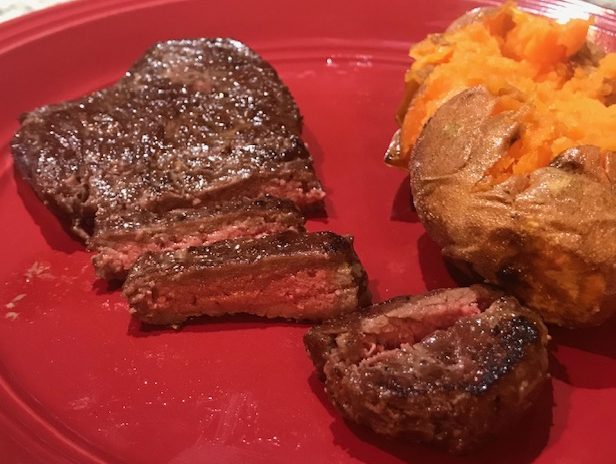
Jason Murphy is a local fitness enthusiast who has spent the last five years learning to take the classic favorite meals of his youth and remake them into healthy dishes. He enjoys sharing with others how food can be both fuel for fitness and fun to eat. Find his list of recipes and photos at www.mysaline.com/shirtless
Sometimes to go forward, you have reverse your thinking. For instance, people trying to eat healthy might think a steak dinner is out of the question. Luckily, with the right cuts of meat and the proper techniques, even a steak dinner can be a meal that doesn’t give you the meat sweats like Joey on Friends after Thanksgiving.
Fats are all the rage right now, but all fats are not created equal. Animal fats from red meat, bacon, and non-grass fed dairy are fats you need to avoid to improve your health and overall well-being. The fats you need to build a healthy lifestyle around are the ones containing omega-3 fatty acid and conjugated linoleic acid from plant based sources like olive oil, avocados, nuts/seeds, and oily fish. The good news is that grass fed beef and dairy also have those benefits.
Compared to standard grain fed beef, grass fed and finished beef has less total fat, more omega-3 and linoleic acid, and more antioxidant vitamins like vitamin E. I know, I can hear some of you saying that grass fed beef is too expensive, but I’ve found that grass fed steak only averages about $1 more per pound over regular beef.
Not only is it better for you, the taste of grass fed beef is noticeably better. It makes standard feed lot grain fed beef seem like you’re eating the inside of a work boot after an overtime shift at the foundry. Also, eating steak isn’t an everyday occurrence, so why not make it the best it possibly can be for both taste and health?
For cuts, I like to use top sirloin to maximize the ratio of protein to fat as well, it’s a leaner cut than most other steaks. The nutrition numbers for a 4-ounce sirloin averages only 150 calories, 6 grams of fat, and 24 grams of protein. Due to the low fat content, this is where technique comes into play to make it as tender and flavorful as more fatty cuts.
The reverse sear method is about as foolproof as it gets for cooking steak, but there are a few crucial pieces of equipment you will need. First, a probe thermometer, so that you will know exactly when to pull your steak from the oven. You can pick these up from anywhere from $12 to $20 depending on the model, and it’s an absolute necessary tool to have for cooking meats of any kind.
Also, a 48 blade meat tenderizer, which you may not be as familiar with, but this magical device can take any cut of meat and help make it as tender as butter. It’s not required to make this steak, but it will definitely make it better. You can pick one up for about $25 online, and once you have it, you will never use an old hammer style meat tenderizer again.
You will also need a 12-inch cast iron skillet for the “sear” portion of the process, because we will be taking this thing to temperatures only heavy elements born in the core of exploding stars like iron can tolerate. Avocado or peanut oil is also a must for this process, because other cooking oils can’t tolerate the heat we will be using for this method. If you don’t have an overhead exhaust on your oven for this part of the process, do like I do and close the doors to rooms with smoke detectors and open some windows, because your kitchen is about to look like Barton Coliseum after an 80’s metal concert.
I like to pair my steak with a baked sweet potato to get some complex carbs, fiber, and vitamins to go with all the protein from the steak. That process is as easy as it gets. Wash and scrub the potatoes, dry them, then poke some holes with a fork so it doesn’t explode while cooking. Give them a rubdown with a splash of olive oil or avocado oil, sprinkle with sea salt, and cook directly on the oven rack at 400 degrees for about 50 minutes to 1 hour. You can do this ahead of time as you will need the oven for the steak method. This has the added benefit of making the sweet potato even better for you, because starches in cooked foods like potatoes that are then cooled and reheated become resistant starch that does not spike blood sugar as much as “fast” starches.
Reverse Seared Steak
Equipment:
- Sheet pan with wire rack that fits inside the sheet pan
- 12 inch cast iron skillet
- Probe thermometer
- 48 blade tenderizer (optional)
- Infrared thermometer
Ingredients:
- 3 -4 grass fed sirloin steaks in the 4 oz range
- 1 tbsp Sea salt
- Fresh cracked pepper to taste
- 2 -3 garlic cloves
- 2 teaspoons Worcestershire sauce
- Avocado oil or spray

Then lightly smash the garlic cloves with the flat side of a chef knife to remove the paper, and rub the garlic cloves on both sides of the steaks.
Lightly sprinkle the steaks with Worcestershire sauce. Season both sides of the steak with salt, then place on the cooling rack inside the sheet pan and place in the fridge uncovered for at least 6 hours and up to 24 hours. After that time is up, preheat the oven to 200 degrees. Grind the pepper on the steaks to your tastes, and then insert the probe thermometer in the side of one steak and cook until it reaches 125 degrees. That will take around an hour. Once it hits that temp, remove the steaks from the oven and let them rest uncovered for 10 minutes. Once the rest period is up, heat your cast iron skillet on the stove top until it hits 550 to 600 degrees using an infrared thermometer. If you don’t have one, test with ½ teaspoon of water in the center of the pan. It should evaporate within 5 seconds. Once the pan is at temp, lightly coat both sides of the steak with avocado oil with either a brush or spray. Sear the steaks on each side for 1 minute using a timer, then rest the steaks on a rack for 5 – 10 minutes.




